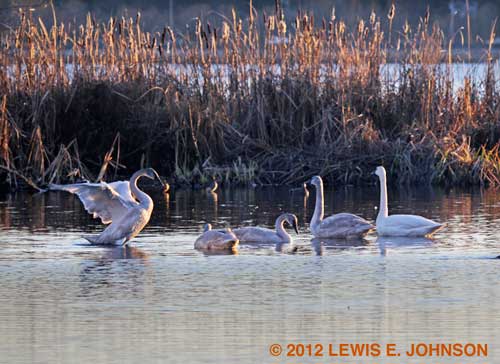January is the season for newbies, the time for us to say goodbye to the old, worn-out year and ring in the hopeful new one. It’s the month we make resolutions to become a newer, better person, the paragon we always wanted to be but so far never were: slimmer, perhaps, with curlier hair (or straighter if you’re already curly), tidier, more organized, dedicated to eating more vegetables. In a sense, January is when we all become young again, free to discover who we really are and what we really can become.
In Western culture, this annual stampede to our personal Big Bang is symbolized by a happy, diapered baby, often wearing (for reasons that escape me), a top hat. At Yesler Swamp, however, beginnings are epitomized by swans. Four juvenile Trumpeter Swans, to be exact.
Their story began last summer. Far away on a tundra pond, four baby swans pecked open their shells and saw the light of day for the very first time. Their snow-white parents worked hard to protect them and shepherd them to the best places to eat plants. Throughout the long days of summer, when the sun never sets, the cygnets grew until at last they reached the size of their parents. Just in time, too, for winter was coming to the Far North. The swan family felt the shortening days and fled, all the way to Yesler Swamp. Here, the young swans are safe. Here they are free to explore their new world. And here their feathers will molt from gray to white, as the juveniles become adults. In the spring they will fly back to the tundra, beginning a cycle that can last more than a decade. For now, they sleep in Yesler Cove in the evenings, paddle into the lake to feed during the day, fly a little, learn a lot, as youngsters should. We are their home.– Constance Sidles
FUN FACTS ABOUT TRUMPETER SWANS
• Trumpeter Swans are the largest and heaviest waterfowl native to North America.
• They can be difficult to tell apart from Tundra Swans. Trumpeters are bigger than Tundras and have all-black bills. Tundra Swans often (though not always) have a spot of yellow on their bills, near the eye. (We have one Tundra Swan visiting us this year.)
• Juvenile Trumpeter Swans are sooty gray all winter long. They don’t molt into the all-white plumage of adults until spring migration.
• It takes four to seven years before Trumpeter Swans begin having babies. However, they choose their lifelong mates between ages two and four.
• In our area, Trumpeter Swans feast on aquatic plants, often tipping up their rear ends to reach deep underwater with their long necks. Farther north, in the Skagit Valley, swans come onto land to graze in fields.
• Parents do not bring food to the babies; rather, they bring the babies to the food. Baby Trumpeter Swans are able to leave the nest and swim almost immediately after hatching and don’t need to be fed by the parents. However, family groups usually stay together until the young are fully grown and can fend completely for themselves.
• Trumpeter Swans used to range throughout North America. Their numbers were reduced by hunting to around 100 birds south of Canada. The population is rising now, thanks to habitat preservation and protection from hunting.
• From the time the Pilgrims arrived in America, Trumpeter Swans were hunted extensively for food and for their feathers, which people thought made the best quill pens.
• Washington State hosts more Trumpeter Swans than any other state except Alaska.

